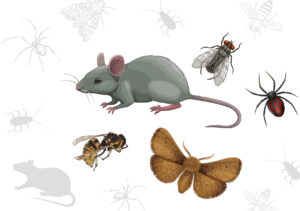When we think of risks to our home we may think of fire, flood, or theft. Yet one of the most overlooked threats comes from something much smaller but no less damaging: pests. From mice chewing through wiring in heritage properties to wood-boring insects weakening period timber beams, infestations can cause significant financial, health, and reputational harm if they aren’t dealt with quickly.
In this article we look at why pest prevention matters for your valuable assets, the signs to watch for, and the practical steps you can take to keep your property safe, pest-free, and protected.
Or you can view our brochure on here: Pest Prevention and Protection.
The hidden costs of pests in properties
It is easy to underestimate how much impact a few pests can have on your property, but once they have made themselves at home, the costs can mount quickly and reach substantial sums. Rats and mice gnaw electrical wiring raising fire risks that could result in losses of hundreds of thousands of pounds, while woodworm and other beetles can weaken original timber floors, period furniture, and heritage building elements worth significant amounts. Beyond structural concerns, rodents spread diseases like leptospirosis, cockroaches are linked to asthma and allergies, and even bedbugs and fleas can trigger secondary infections that create health risks for occupants.
Why winter is a critical season for premium properties
Although pests can appear year-round, autumn and winter bring extra risks. As temperatures fall, rodents, spiders, and insects seek warmth indoors. Lofts, garages, and wall cavities make perfect shelters.
For owners of country houses and estates, this means being extra vigilant when the cold sets in. Seal gaps, store food securely, and keep clutter to a minimum. For landlords, seasonal inspections or even a professional pest control contract, are well worth the investment to protect valuable assets.
Pest problems signs in your property
Here are some of the most common signs to look out for:
- Bees ans wasps: increased number of bees and wasps in a specific area, visible entry points such as holes or cracks in structures, and the presence of buzzing sounds.
- Rodents: droppings in cupboards, gnawed food packaging, scratching at night.
- Insects: trails of ants in kitchens, clusters of small holes in timber, or moth damage to fabrics and furnishings.
- Spiders and silverfish: usually found in damp or undisturbed areas like lofts, wine cellars, or basements.
- Moths: tiny holes in clothing, textiles, or carpets, often with webbing or larvae nearby.
Make it a habit to check storage areas, lofts, and less-used corners regularly, especially in winter. For larger properties or multiple holdings, consider professional inspection services.
 Proactive steps to reduce your risk
Proactive steps to reduce your risk
- Seal entry points: block gaps around doors, windows, pipes, and rooflines – particularly important in period properties with traditional construction methods.
- Stay clean and tidy: store food in sealed containers, clear up crumbs quickly, and take rubbish out regularly.
- Control moisture: pests love damp conditions – fix leaks and use dehumidifiers in basements, wine cellars, and period buildings prone to moisture issues.
- Schedule regular checks: keep an eye on lofts, garages, cellars, and outbuildings. For multiple properties, consider systematic inspection schedules.
- Call in the experts: for serious infestations, a professional pest control service with experience in high-end properties is the safest solution.
Taking action now to protect your home
Pest prevention can make a significant difference to your safety, finances, and peace of mind. A clean, pest-free home is healthier, easier to insure, and more enjoyable to live in – while maintaining its value.
By staying proactive – sealing gaps, keeping food secure, reducing clutter, and scheduling inspections – you will be protecting your home from avoidable risks.
Get in touch for help and advice
If you have any concerns or queries on your insurance cover please don’t hesitate to speak to us.
You can call any of the team on 0203 002 9859 or email pcl@jameshallam.co.uk

